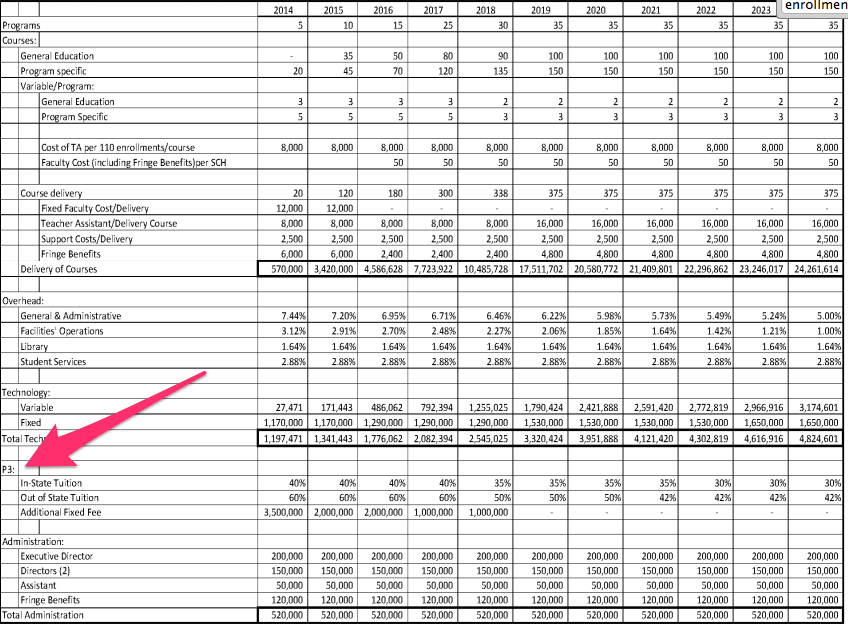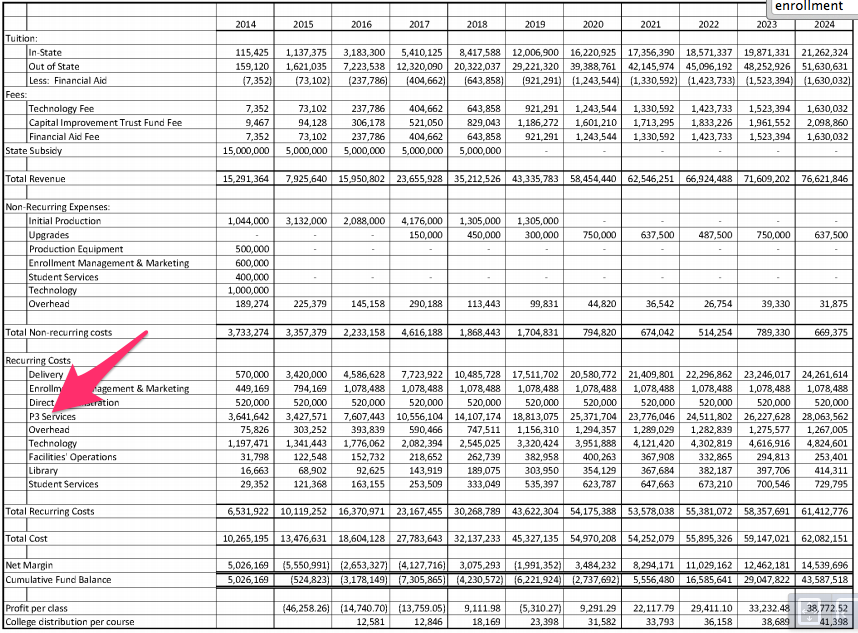I wrote a post over the weekend that included information from the Gainesville Sun about the University of Florida Online (UF Online) program and its expected payments to Pearson Embanet. Chris Newfield from Remaking the University also wrote on the subject today. Chris raises some very important issues in his post, including his point:
Universities may have a cost disease, but they now have a privatization disease that is even worse.
In the article, however, there seems to be a misunderstanding of how the revenue sharing agreement works. Given the importance of the questions that Chris raises, I think it is important to understand the payment model used by most Online Service Providers (OSP) such as in place at UF Online.
The part of the blog post that is mistaken, in my understanding, is this [emphasis added]:
UF did admit that it had to pay Pearson cash up front: it just wouldn’t say how much. A week later, Mr. Schweers reported that through various documents he’d been able to show that UF would pay Pearson Embanet $186 million over the 11 year life of the contract. The business plan sounds much like the Udacity-Georgia Tech deal. It involved very large growth projections to 13,000 students paying full in-state or non-resident tuition for an all-online program by 2018, with Pearson getting, in addition to its fee, $19 million of $43 million in projected revenues. 13,000 is the size of UF’s first year class.
The revenue estimates are worth pondering. Even if Pearson fails, it will effectively pocket all of the state funding that was given to UF for online, and some internal UF money besides. Pearson is owed $186 million over time for getting involved, and the state provided $35 million. Pearson will contractually absorb all of the state money and then be entitled to another $151 million of UF’s internal funds. (UF Associate Provost Andy McDonough says that Pearson will get $9.5 million in the first five years, but it is not clear whether or how this reflects the still partially redacted contract.)
If somehow the Pearson dragnet finds thousands of students to pay full tuition for an all-online program with the University of Florida name, UF is slated to gross $24 million in 2019, which is projected to rise to $48 million five years later. In this best possible scenario, UF will get back its initial $151 million around ten years from now. The University will thus be ready to earn its first net dollar in 2025.
The basic idea is that the OSP provides up-front investment, spending far more money in the initial years of an online program than it makes from the school. This is why 2U is growing quickly ($83.1 million revenue on 49% growth) but still is losing big ($27.9 million last year, with unclear prospects on breaking even). Most of 2U’s programs are in the early stages, when they are investing more in the online program than they are making in revenue.
In the UF Online case, they appear to be paying Pearson Embanet $9.5 million for the first five years as partial compensation for these up-front expenses. I believe that Pearson will internally spend far in excess of $9.5 million over the next five years, running a loss. During that same startup period, however, the Florida legislature will fund UF Online with $35 million. Pearson will only make 27% of this money if the Gainesville Sun is correct in its analysis of the contract.
After 2019, all payments shift to revenue from tuition and fees paid by students, as described by the Sun:
After 2018, UF will also stop paying Pearson directly and Pearson’s income will come entirely from its share of tuition revenue and any fees it charges. UF projects it will have over 13,000 students in UF Online generating $43 million in tuition revenue by 2019 — of which Pearson will get close to $19 million.
By 2024, with 24,000 students anticipated, revenues generated will be about $76 million, with $28 million going to Pearson, McCullough said.
OSPs typically take a percentage of the tuition revenue based on enrollment targets. What is important here is that the revenue for the OSP depends on enrollment – if UF Online does not hit the enrollment targets, Pearson Embanet will not get $186 million in revenue. They make a percentage of the revenue without guaranteed payments.
In the best possible scenario for UF Online and for Pearson Embanet, the school will start making money from students on day 1. In 2019, if UF Online hits enrollment targets, UF Online will net $24 million ($43 million of revenue, paying $19 million to Pearson Embanet). As the enrollment grows (again, assuming that it does), then UF Online will make more and more over time, estimated to be net $44 million in 2024 ($76 million of revenue, paying $28 million to Pearson Embanet). If UF Online does not hit targets, both UF Online and Pearson Embanet will make far less than the projections in the article.
As mentioned before, Chris raises some important questions, but this is not a matter of a school paying all revenue to an OSP without seeing a dime of net revenue until 2025 and beyond.
Update (3/31): I found the spreadsheets in the business plan, and these contract numbers are directly derived from the plan. The key is that they label Pearson Embanet (OSP) as “P3” for Public / Private Partnership (see page 87 for explanation.
As for the mechanism to pay Embanet, they use a moving scale, with different percentages of revenue split per year and per in-state or out-of-state tuition. In 2015 Pearson Embanet makes 40% of the in-state tuition and 60% of the out-of-state tuition, and then in 2022 they make 30% and 42%. This also shows the “Additional Fixed Fee” of $9.5 million broken up over the first five years. See here on page 84:
On page 82 these numbers are applied to the estimated enrollment, with the resultant fee to Pearson Embanet labeled as “P3 Services”. This combines the tuition sharing along with the additional fixed fee. For example in 2016, ($3.2 m * 0.4) + ($7.2 m * 0.6) + $2.0 m = $7.6 million. If you add up the row labeled “P3 Services” you get the total of $186 million.
What is unknown from this analysis is the internal costs from Pearson Embanet. The document on page 87 includes the following language, which seems to quantify the Embanet “investment” as “direct cost savings realized from these transfers” at $14 million per year.
There are some recognizable cost transfers in the service purchase, “partnership” plan. It is admittedly difficult to capture all of the services that are part of an external package in an internal matrix subject to per unit, per student, or per activity pricing. However, there are recognizable cost transfers in the market assessment, marketing services, recruitment, contact call center, production (on demand), program coordinators (retention), digital content and tutoring. The direct cost savings realized from these transfers is estimated at about $14 million per year. The present value of the P3 services annualized is approximately $15 million. The University believes the summation of the immediacy of the expertise, the on-request availability, the joint research opportunities, and the expanding innovative digital content represent greater value added than the differential.
Update (2): Note that these are projections that seem to be best-case scenarios.
Full disclosure: Pearson is a client of MindWires Consulting but not for OSP. All information here is from public sources.


I’ve posted an update in response to Phil Hill’s post–retraction of some of my calculations, and expansion of the overall argument. Many thanks for the analysis.